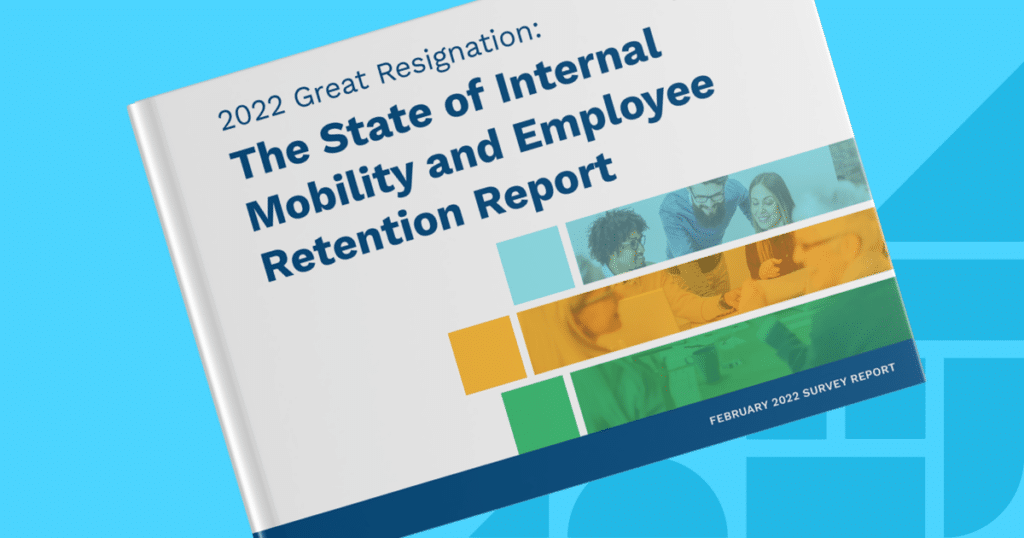Internal mobility may seem like a relatively new concept, but attracting and retaining top talent certainly isn’t. In fact, studies are finding that a company’s ability to keep its best employees from jumping ship remains in the top-five concerns for executive teams.
One of the most effective ways to ensure your top talent sticks around is by providing them with upskilling and promotional opportunities — otherwise known as internal mobility.
What is internal mobility, exactly?
Internal mobility refers to the movement of employees within an organization. An internal mobility strategy takes this a few steps further by implementing a process or framework for moving existing employees between roles, vertically and laterally.
Closely linked to career agility — where recruiters are hiring with a candidate’s ability to adapt to changing business needs and landscapes in mind — internal mobility is no longer a ‘nice to have,’ but a must-have.
However, there are different types of internal mobility your talent team can leverage to:
- Expand your candidate pool and talent pipeline
- Drive diversity recruiting initiatives
- Improve your recruitment marketing
- Support the growth of your existing employees
- Uncover skills and capabilities that already exist in your teams
Let’s dive deeper into the different types of internal mobility opportunities you can provide candidates and employees alike — and how they’ll grow with your organization.
The different types of internal mobility
There are several different types of internal mobility that you can infuse into your talent management strategy for both existing and new employees. We break down each type below.
Lateral mobility
Lateral mobility refers to the types of role changes where an employee moves from one position to another within your organization with little or no change in compensation or seniority.
Think of this as role mobility, where an existing employee can join a different team by applying similar skills from their current role to their new one.
For example, a member of Marketing could be a great fit for a Sales role, as their marketing skills, knowledge, and insights into your customers would benefit your Sales team.
It’s important to keep in mind that lateral mobility can still be of benefit to your company and its employees. If you find some employees feel “stagnant” in their careers, would like to take on new challenges, or have a desire to test a new role, moving them laterally provides them with opportunities to upskill while applying what they already know of your business to a new team.
Consider that lateral mobility also benefits recruiting teams who can hire internally without needing to invest time and money in sourcing net-new candidates for roles that are well suited to existing talent.
[Bonus: You can learn more about the state of internal mobility and how it’s impacting employee retention today by checking out our in-depth Great Resignation Report.]

Promotions
While a promotion may seem like the only option at times, leaders will often reserve this upward mobility opportunity for the recognition of an employee’s hard work and performance.
In this way, promotions benefit the professional development and personal growth of a given employee (and reward them with greater pay).
However, promotions do not have to be cross-functional in order to be rewarding.
Let’s say, for instance, that your Senior Recruiter is promoted to Recruitment Manager. This upward mobility comes with a change in salary and title but doesn’t necessitate that employee to move teams or alter their job function.
In other respects, a promotion could see an employee being moved from one role into another so the new team can benefit from the employee’s skills and expertise.
Regardless of how you choose to promote employees, upward mobility should focus on leveling up team members to more senior positions, especially if your org is striving to increase the engagement, satisfaction, morale, productivity, and diversity of your leadership team.
Career agility
In a nutshell, career agility refers to one’s ability to keep pace with the demands of the modern business landscape. Employees who are agile in both mindset and skills are considered to have a greater ability in adapting to new roles, changing work environments, and business demands.
At its core, career agility is meant to help optimize a person’s creativity while encouraging them to pursue new skills, growth, and overall career satisfaction.
In other words, employees are given more control over their career progression.
A great example of how career agility works is by considering transfers or job swaps.
With a transfer, an employee can try working from a new location or headquarters, or move to take on a new role within the same department at another company office.
Job swaps, on the other hand, allow employees to temporarily switch to related roles elsewhere in the business so they can upskill while exploring different opportunities.

Mentorship or coaching
Many orgs focus their efforts on creating mentorship or coaching programs, wherein employees can work with or shadow experienced team members to learn new skills, better understand the ins and outs of other roles, and benefit from a coworker’s professional experience.
Mentorship may not seem like an internal mobility tactic, however, offering employees mentorship or coaching opportunities can better prepare them for role changes, upcoming promotions, leadership and development opportunities, and more.
Coaching or mentoring can go hand-in-hand with project-based mobility, which means creating cross-functional teams of employees who can work on a one-off project together to drive certain business objectives and goals.
What’s interesting about this approach is that, with project-based mobility, colleagues can explore other roles and learn from one another, especially those colleagues with whom they may not work closely with on a regular basis.
You could, for example, pair senior sales managers with mid-level marketing associates who are interested in potentially moving to the Sales team.
Similarly, Copywriters could be added to a project with Product Marketing to learn more about bridging the gap between their existing skills and those needed to move into a PM role.
Why you should leverage different types of internal mobility
Employees who are agile, adaptable, and versatile are becoming more coveted by orgs — and more competitive among candidates — while setting themselves up for long-term career success. As an employer, you can benefit from those attributes while helping your talent.
While the benefits are numerous, here are some of the top benefits we believe both businesses and employees can reap from leveraging different types of internal mobility as part of your talent management strategy:
- Day-to-day growth in a current role, versus changing jobs or companies to find new growth opportunities
- Shift from what an employee ‘should do’ in a role to what they ‘can’ or ‘want’ to do
- More hands-on involvement from the employee in their career development and work
- Greater flexibility in the nature or type of work an employee does, and the work they’re exposed to
- Find new ways to develop unique or niche skills while building on existing skillsets
These benefits may seem like common workplace benefits of any team, but when practiced regularly by both employees and managers, the outcome can be a game-changer for organizations looking to leverage internal talent.
Start leveraging different types of internal mobility at your organization today
In a world where the competition for talent is fierce, leveraging the star employees you already have, and focusing on the future potential of candidates, can help both your recruiting team and organization at large adapt to the demands and realities of hiring today.
Our complete guide to internal mobility empowers recruiters with everything they need to know to drive internal mobility. Get your free copy of our guide below.




